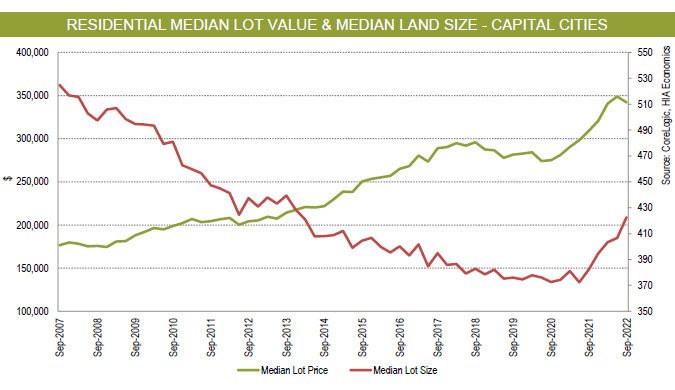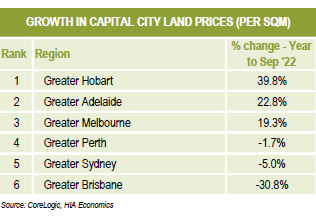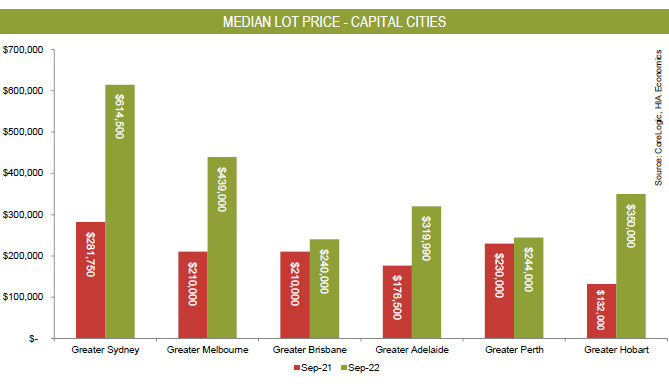Glory days over as residential land prices decline
Interest rates have finally dragged land sales into price fall territory after a couple of years of strong growth, with two major east coast cities precipitating the downturn.
Large price falls in Brisbane and Sydney have dragged land sales values down nationally after two years of strong growth.
Values in Greater Brisbane also down for the quarter by 14.3 per cent, while Sydney’s median land price was down 8.6 per cent in the September quarter and 11.6 per cent over the past two quarters.
Modest growth Melbourne, Hobart, Adelaide and Perth was not enough to stop land sales slipping into negative territory nationally.
The HIA-CoreLogic Residential Land Report, which provides updated information on sales activity in 51 housing markets across Australia, showed new residential land prices declined by 0.2 per cent in the September Quarter 2022 to $328,954.
This followed a stellar run in which new residential land prices rose 26 per cent in less than two years.
The overall national trend means land has joined the wider property market in a downwards trajectory, after national property prices recently experienced the largest housing market decline on record.

Housing Industry Association (HIA) Senior Economist, Tom Devitt, said the stabilisation of new residential land prices and falling sales volumes did not reflect an end to underlying shortages of land.
“Rather, they reflect a combination of worsening affordability and the shock of the RBA’s rate hiking cycle to consumer confidence and borrowing capacity.
“Declining prices, together with record low sales volumes, are disguising the underlying shortage of land in the short term.
“Sales volumes started plummeting two years ago when land prices were soaring, which is strongly indicative of a shortage of shovel-ready land in the face of strong demand.
“The recent price declines have also coincided with the steepest rate hiking cycle in a generation.”

Mr Devitt said a recovery in demand depends largely on the RBA’s future cash rate decisions, a view shared by other industry professionals.
Nigel Satterley, founder and Chief Executive of Satterley, told API Magazine that land prices across Australia would rebound quickly.
“The steep rise in civil construction costs will see land prices across Australia increase by about 5 per cent in the coming months.”
Ballarat-based Ben Halsall, responsible for land sales for Buxton, said the frequency of interest rate increases has, for now at least, had an impact on those looking to purchase.
“The impact on affordability of higher interest rates and restricted borrowing capacity has simply translated into moderated land sales rates.
“This in turn will reduce the frequency of new stage releases and land options coming to market.”
Mr Devitt said that when demand recovers, the underlying shortage of developable land will further worsen the affordability challenges already facing aspiring homeowners and renters.
“Lower land prices and more affordable housing must be driven by a greater supply of land, shorter delivery times and fewer regulatory and tax imposts, not by the destruction of confidence,” Mr Devitt said.
Land sales around the country
Despite Sydney slipping more than 11 per cent over the past two quarters, it remains Australia’s most expensive market, with lot prices at $614,500, which is still up by 7.8 per cent on a year earlier.
The median price of residential land in Greater Melbourne also surged during the pandemic, but not as fast as in Greater Sydney. Greater Melbourne is the second most expensive capital city for residential land in Australia with lot prices still increasing, up by 4.5 per cent in the September Quarter 2022 to a new high of $439,000. This is up by 26.1 per cent compared to a year earlier.
In regional Victoria, Mr Halsall said developer pricing has held in the face of rising interest rates.
“With very low rental vacancy rates, population movement to regional Victoria due to better affordability, decentralisation, and lifestyle, and also excitement about the 2026 Commonwealth Games in Ballarat in particular, there is a lot of optimism about future prospects regionally.”

Over the course of the pandemic, Greater Hobart has overtaken Brisbane, Perth and Adelaide to become the third most expensive capital city for residential land.
Prices in Greater Hobart are even higher now than they were in Greater Melbourne at any time before the pandemic. The median price of residential land increased by 16.7 per cent in the September Quarter 2022 to a new high of $350,000. This is 29.6 per cent higher than a year earlier.
We are currently seeing a solid level of land supply as civil construction delays ease.
- Nigel Satterley, Chief Executive, Satterley
Adelaide overtook Brisbane and Perth during the pandemic to record a median price of $319,990 in the September Quarter 2022, up by 6.7 per cent on the previous quarter and 45.8 per cent higher than the same time a year earlier.
The median price of residential land in metropolitan Perth was $244,000 in the September Quarter 2022, up by 1.5 per cent on the previous quarter and 0.4 per cent higher than a year earlier.
Mr Satterley suggested supply issues were easing in Western Australia, Victoria and Queensland, where Satterley's operations were based.
“We are currently seeing a solid level of land supply as civil construction delays ease and activity gets back on track and I expect this will ease further within six months.
“In WA, land sales in the growth areas are sitting at about 100 a week, in Victoria (including Geelong and Ballarat) land sales are at about 225 a week, and in South East Queensland about 100-150 a week.”
At $240,000, Brisbane’s median price is 1.3 per cent up on a year earlier even allowing for it having the biggest recent reversal of fortunes, making the Queensland capital the most affordable capital city for land in the country.
The weighted median price of residential land for the capital cities was $342,072, down by 1.9 per cent per cent over the quarter, though still up by 10.7 per cent compared to the same period a year earlier.
East coast interest rate sensitivity
The impact of rising interest rates on land prices could well depend on which side of the country you’re talking about.
According to Tanya Steinbeck, CEO of the WA chapter of the Urban Development Institute of Australia (UDIA WA), the east coast states could be more susceptible to another round of rate hikes.
“Further interest rate hikes will work to dampen buyer demand, however, this is likely to be felt much more acutely on the east coast than in WA, where prices have not experienced the escalations that have occurred in other capital cities,” Ms Steinbeck told API Magazine.
“Given ongoing demand for new land, UDIA WA expects that prices in WA will remain steady and constraints on supply will remain albeit less critical.”
“Perth new land prices have remained relatively stable throughout the Covid pandemic and into the last year with prices rising incrementally due to WA’s strong economic growth, high employment rate and positive overall outlook.
“Ongoing supply constraints have also put pressure on prices as developers reflect higher materials and skills costs.”
As reflected in a chronic shortage of rental properties and affordable and social housing, Ms Steinbeck said there was no argument that an increase in supply was needed in 2023, but constraints on industry being able to deliver that supply remained, particularly due to the ongoing skills shortages.
“Despite the seriously constrained housing supply pipeline, unlike in other parts of Australia, the WA land market remained relatively steady in terms of average land value, with the average price of new land in the Perth Metro Area (according to UDIA WA figures) peaked at around $247,000 in September quarter of 2021 and is now back down to around $232,988 which is well below the average in other capital cities.”





















